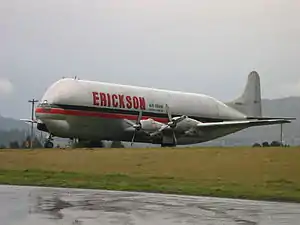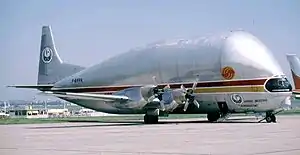Aero Spacelines
Aero Spacelines, Inc. was an American aircraft manufacturer from 1960 to 1968 which made a name for itself by converting Boeing 377 Stratocruisers into the famous Guppy line of airplanes, re-engineered solely for transporting oversized cargo such as space exploration vehicles.
 | |
| Founded | 1960 |
|---|---|
| Founder | John M. Conroy |
| Defunct | 1968 |
| Products | |

History
Aero Spacelines was formed with only one customer in mind — the National Aeronautics and Space Administration. NASA required a way to transport outsize cargo from their various manufacturing plants, such as the Michoud Assembly Facility in New Orleans, Louisiana, to Cape Canaveral Air Force Station in Florida. These freight shipments were too large to be safely transported by rail or truck. Shipping by sea was too time consuming, expensive, and fraught with the danger of damaging the cargo on turbulent seas. The only viable means of transporting NASA's cargo was by air. However, due to the large size of the components, no existing aircraft was capable of accomplishing the task.
John M. "Jack" Conroy, a retired United States Air Force pilot, and Lee Mansdorf, an aircraft salesman and entrepreneur, formulated the Guppy concept one evening over dinner. It was decided a company needed to be established to manufacture outsized aircraft. Conroy hired Robert W. Lillibridge as vice president of manufacturing and engineering, and a team was assembled for the project. Financing was provided by venture capitalist William Ballon, a World War II combat veteran also from the Army Air Corps. Once the company was established at Van Nuys Airport, California, Aero Spacelines began operation in 1960 to engineer the transformation of the Boeing 377 airliner into the Pregnant Guppy.[1]
Among the earliest of NASA's shipments utilizing the Pregnant Guppy were the first and second stages of the Project Gemini's Titan II GVL from the Martin Co. in Baltimore, Maryland, to Cape Canaveral, Florida. Subsequent versions of the Guppy series transported the S-IVB, the third stage of the Saturn booster from California to Florida.
In 1967, Aero Spacelines encountered financial difficulties and was acquired by Unexcelled Inc. That corporation was sold to Tracor Aviation. Jack Conroy organized a new company, Conroy Aircraft, which built more airplanes for transporting oversized cargo. By November 1968, NASA had paid Aero Spacelines $11,591,633 in contracts.[2] Conroy ceased operations in 1972.
As of November 2019, one Super Guppy was still in operation. NASA utilizes it to transport its vehicles as needed, and leases it to third parties when not in use.[3]
In early 2016, NASA used that aircraft to transport the main structure of Orion crew capsule, from its Michoud Manufacturing Facility in New Orleans, Louisiana, to the Kennedy Space Center in Florida, where the capsule will undergo its first uncrewed test flight aboard the Space Launch System rocket.[4] In November 2019 NASA used the aircraft to transport the Orion capsule from the Kennedy Space Center to the Mansfield Lahm Airport in Ohio for thermal and vacuum tests.[5]
List of aircraft
Aero Spacelines produced three Guppy aircraft models while it was in business.
- Pregnant Guppy (1962) - 1 built
- Super Guppy (1965) - 5 built
- Mini Guppy (1967) - 2 built
References
- Mondey, p. 9
- https://history.nasa.gov/SP-4206/notes.htm#10.37
- "NASA website, updated 12 July 2012: 377SG-201 is still in use". Archived from the original on 2013-02-15. Retrieved 2013-02-11.
- https://www.nasa.gov/feature/glenn/2019/orion-spacecraft-arrives-in-ohio-aboard-the-super-guppy
External links
- Pregnant Guppy : THE PLANE THAT WON THE SPACE RACE Bloom, Margy. May / June 2010, PILOTMAG Magazine
- It's a Plane: One man's obsession, it helped get us to the moon Tripp, Robert S. Spring 2002, American Heritage of Invention and Technology
- Page about Airbus Industrie's Beluga
- Site about The Guppy Family of Aircraft
- http://www.nasa.gov/centers/johnson/multimedia/aod/S69-41985.html
- The Day the Super Guppy Blew Her Top